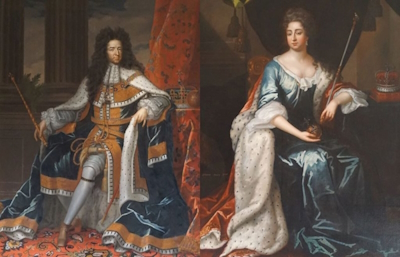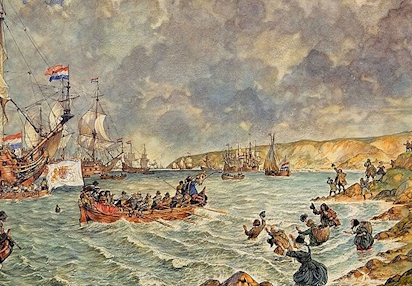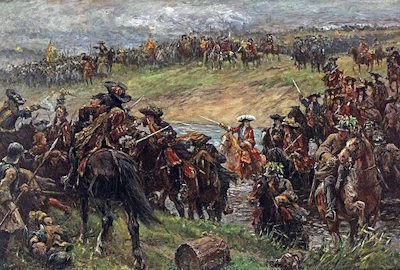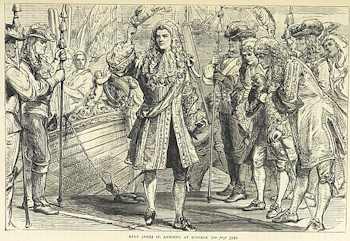 The ‘Glorious Revolution’, or de Glorieuze Overtocht in Dutch, is often called the Bloodless Revolution as there was very little bloodshed in England itself, although in Ireland it was a particularly bloody affair. Most ordinary people weren’t directly affected by the invasion as they had been during the Civil Wars (1642-52). In his book The King Over the Water, Desmond Steward said of it: “The events of 1688 were not so much a revolution as an aristocratic coup d’etat that ended in a one party state …” The events of 1688 were probably more significant politically for England than the Civil Wars as there were very few real changes to the system after the latter. Although William was invited to take the throne by some notable English figures, his arrival on British shores is still viewed by many as an invasion of England by the Dutch to remove a potential ally of Louis XIV of France. The mainly Protestant population of England feared James would try to impose Catholicism on the kingdom and were alos anxious that he appeared to support the Divine Right of Kings, which would lead to an increasing absolutism similar to that of Louis XIV in France. James’s suspension of parliament in 1685 only served to confirm these fears.
The ‘Glorious Revolution’, or de Glorieuze Overtocht in Dutch, is often called the Bloodless Revolution as there was very little bloodshed in England itself, although in Ireland it was a particularly bloody affair. Most ordinary people weren’t directly affected by the invasion as they had been during the Civil Wars (1642-52). In his book The King Over the Water, Desmond Steward said of it: “The events of 1688 were not so much a revolution as an aristocratic coup d’etat that ended in a one party state …” The events of 1688 were probably more significant politically for England than the Civil Wars as there were very few real changes to the system after the latter. Although William was invited to take the throne by some notable English figures, his arrival on British shores is still viewed by many as an invasion of England by the Dutch to remove a potential ally of Louis XIV of France. The mainly Protestant population of England feared James would try to impose Catholicism on the kingdom and were alos anxious that he appeared to support the Divine Right of Kings, which would lead to an increasing absolutism similar to that of Louis XIV in France. James’s suspension of parliament in 1685 only served to confirm these fears.
Although James made no open attempt to impose Catholicism on the country, he did propose tolerance towards Catholics and non-conformists with the Declaration of Indulgence in 1687, which was deemed unacceptable to most Anglicans, especially at a time when the Catholic Louis XIV was in the process of revoking the rights of Protestants in France. There was also opposition to James’s son, James Francis Edward Stuart, from his second marriage, to the Catholic Mary of Modena, who despite being Catholic was the rightful heir to the throne according to 17th century law. Additionally, James II was hostile towards the Dutch as a result of three previous wars recently fought against them, and their support for the Monmouth Rebellion in England and the Argyll Rising in Scotland in 1685. This hostility led to Dutch fears that James II would ally himself with France against them. At first, James’s subjects were reluctant to rebel, not wishing a repeat of the devastating civil wars which had led to the execution of a king and the establishing of the unpopular Protectorate under Oliver Cromwell.
The Dutch invasion
 William of Orange, Stadtholder of the Dutch Republic, was deemed a suitable althernative candidate for the throne because he was a Protestant and both James II’s son-in-law and nephew. Wiliam’s wife Mary was James’s daughter from his first marriage, with Anne Hyde, who had died in 1660. Mary had been brought up as an Anglican Protestant. William landed in England with an invasion force of over 15,000 soldiers in November 1688 to depose the unpopular Catholic James II at the behest of six leading noblemen and one bishop known as The Immortal Seven. These seven notables represented a cross-section of leading society including Thomas Osborne, 1st Duke of Leeds, who was a Tory politician and William Cavendish, 1st Duke of Devonshire , who was a Whig; Henry Compton, Bishop of London, acted for the church; Richard Lumley, 1st Earl of Scarbrough for the army; Edward Russell, 1st Earl of Orford for the navy. Bad weather prevented the English fleet from intercepting the Dutch ships, so William’s force was able to land at Brixham in Devon and march on London from there. Except for a handful of minor skirmishes, William’s invasion was virtually unopposed with many of James’s mainly Protestant officers and soldiers even defecting to his cause.
William of Orange, Stadtholder of the Dutch Republic, was deemed a suitable althernative candidate for the throne because he was a Protestant and both James II’s son-in-law and nephew. Wiliam’s wife Mary was James’s daughter from his first marriage, with Anne Hyde, who had died in 1660. Mary had been brought up as an Anglican Protestant. William landed in England with an invasion force of over 15,000 soldiers in November 1688 to depose the unpopular Catholic James II at the behest of six leading noblemen and one bishop known as The Immortal Seven. These seven notables represented a cross-section of leading society including Thomas Osborne, 1st Duke of Leeds, who was a Tory politician and William Cavendish, 1st Duke of Devonshire , who was a Whig; Henry Compton, Bishop of London, acted for the church; Richard Lumley, 1st Earl of Scarbrough for the army; Edward Russell, 1st Earl of Orford for the navy. Bad weather prevented the English fleet from intercepting the Dutch ships, so William’s force was able to land at Brixham in Devon and march on London from there. Except for a handful of minor skirmishes, William’s invasion was virtually unopposed with many of James’s mainly Protestant officers and soldiers even defecting to his cause.
It is possible that William was planning to invade even without an invitation, as he had already increased the size of the Dutch navy not long before he was asked to take the throne, already fearful of potentially having a Catholic power positioned on either side of his small country. At first, he claimed he wasn’t interested in the throne of England for himself, but simply wanted to secure it for his Protestant wife, but latter it became clear that this wasn’t the case. William soon demanded to become joint monarch or he would return home, and Mary stated she would only accept being queen if she could rule jointly with her husband. They were both accepted as joint monarchs, the only case of king and queen regnant in Britain, as it was usual that one of the royal couple was a consort. Realising his lack of support among the population and doubting the loyalty of his troops, James attempted to flee to France. Initially, he was captured and imprisoned, but later allowed to escape, as William wanted to avoid the inconvenience of having an imprisoned king in his new realm. At this time, there was a general reluctance to kill another king after experiencing the repression against those who had been responsible for the execution of Charles I in 1649 once the monarchy had been restored in 1660. Charles II had issued a general pardon on ascension to the throne, but showed no mercy to those who had been directly involved in sending his father to his death.
War in Scotland and Ireland
 Despite being unpopular in England, James enjoyed much popular support in Scotland and Ireland. There was great sympathy in Scotland for the traditional Scottish ‘Stuart heir’ despite the unpopularity of James’s religion. The resentment of a foreigner seizing the throne from the rightful Scottish air led to the Jacobite Rising of 1689-91. Although initially victorious with the defeat of an English army at Killiecrankie in 1689, the Scottish rising was soon suppressed, although resistance continued in the Highlands until 1692. The repression of the Jacobites culminated in the Glencoe Massacre, when on 13th February 1692 thirty-eight Macdonalds were massacred by soldiers in a cold-blooded breach of highland hospitality. In Ireland there were many Catholic lords who supported James, as he had been in the process restoring many of their lost powers to them. James was also popular among some Irish Protestants, because the Church of Ireland depended on Royal support for its survival while Ulster was dominated by Presbyterians who supported James’s tolerance policies. Additionally, both Catholic and Protestant merchants in Dublin and elsewhere objected to commercial restrictions which placed them at a disadvantage to their English competitors. In 1689 rebellions broke out and the Irish under the Earl of Tyrconnell took over most of Ireland. James arrived with a contingent of 6000 French troops, gaining control of all of Ireland except for the Protestant north. The unsuccessful siege of the port of Derry by the James’s forces lasted a year until William led an army to Ireland to put down the rebellion. The conflict became known as the Williamite War, or the War of the Two kings. The Battle of the Boyne was fought on 1st July in 1690 between the two kings, which although resulting in a victory for William, was not decisive militarily. The defeat for James did succeed in disheartening his supporters, and with the arrival of more reinforcements for William, James fled back to France to live out his life in exile. The war dragged on another year until the Franco-Irish army was finally defeated at Aughrim on 12th July 1691, although some say the war had effectively been lost the moment James fled the country.
Despite being unpopular in England, James enjoyed much popular support in Scotland and Ireland. There was great sympathy in Scotland for the traditional Scottish ‘Stuart heir’ despite the unpopularity of James’s religion. The resentment of a foreigner seizing the throne from the rightful Scottish air led to the Jacobite Rising of 1689-91. Although initially victorious with the defeat of an English army at Killiecrankie in 1689, the Scottish rising was soon suppressed, although resistance continued in the Highlands until 1692. The repression of the Jacobites culminated in the Glencoe Massacre, when on 13th February 1692 thirty-eight Macdonalds were massacred by soldiers in a cold-blooded breach of highland hospitality. In Ireland there were many Catholic lords who supported James, as he had been in the process restoring many of their lost powers to them. James was also popular among some Irish Protestants, because the Church of Ireland depended on Royal support for its survival while Ulster was dominated by Presbyterians who supported James’s tolerance policies. Additionally, both Catholic and Protestant merchants in Dublin and elsewhere objected to commercial restrictions which placed them at a disadvantage to their English competitors. In 1689 rebellions broke out and the Irish under the Earl of Tyrconnell took over most of Ireland. James arrived with a contingent of 6000 French troops, gaining control of all of Ireland except for the Protestant north. The unsuccessful siege of the port of Derry by the James’s forces lasted a year until William led an army to Ireland to put down the rebellion. The conflict became known as the Williamite War, or the War of the Two kings. The Battle of the Boyne was fought on 1st July in 1690 between the two kings, which although resulting in a victory for William, was not decisive militarily. The defeat for James did succeed in disheartening his supporters, and with the arrival of more reinforcements for William, James fled back to France to live out his life in exile. The war dragged on another year until the Franco-Irish army was finally defeated at Aughrim on 12th July 1691, although some say the war had effectively been lost the moment James fled the country.
The aftermath
 The historical event was named the Glorious Revolution by the victors because they succeeded in their aims, but had it gone wrong it might have just been remembered as a failed Dutch invasion of England. It could be regarded as the climax of the conflict between Catholics and Protestants in England set in motion by Henry VIII, who was excommunicated by Pope Paul III in 1538. The Glorious Revolution could also be viewed as the apex of the struggle for power between the monarchy and parliament, which went back as far as the Magna Carta of 1215. According to Daron Acemoglu and James A. Robinson in their book Why Nations Fail, the events of 1688 signalled the start of Industrial Revolution: “This dynamic process was unleashed by the institutional changes that followed from the Glorious Revolution.” The following period resulted in the decline of mercantilism, the promotion of liberalism, and the forming of the Bank of England 1694. After 1688, the government of England became more pluralistic, and more liberal towards trade, both ending the government-sanctioned monopolies of the autocratic Stuart monarchs and making property rights more secure. In 1915, constitutional theorist A. V. Dicey said of Parliament’s new found powers that “[Parliament] has, under the English constitution, the right to make any law whatever; and further, that no person or body is recognised by the law of England as having a right to override or set aside the legislation of Parliament.”
The historical event was named the Glorious Revolution by the victors because they succeeded in their aims, but had it gone wrong it might have just been remembered as a failed Dutch invasion of England. It could be regarded as the climax of the conflict between Catholics and Protestants in England set in motion by Henry VIII, who was excommunicated by Pope Paul III in 1538. The Glorious Revolution could also be viewed as the apex of the struggle for power between the monarchy and parliament, which went back as far as the Magna Carta of 1215. According to Daron Acemoglu and James A. Robinson in their book Why Nations Fail, the events of 1688 signalled the start of Industrial Revolution: “This dynamic process was unleashed by the institutional changes that followed from the Glorious Revolution.” The following period resulted in the decline of mercantilism, the promotion of liberalism, and the forming of the Bank of England 1694. After 1688, the government of England became more pluralistic, and more liberal towards trade, both ending the government-sanctioned monopolies of the autocratic Stuart monarchs and making property rights more secure. In 1915, constitutional theorist A. V. Dicey said of Parliament’s new found powers that “[Parliament] has, under the English constitution, the right to make any law whatever; and further, that no person or body is recognised by the law of England as having a right to override or set aside the legislation of Parliament.”
As for the monarchy, it was unprecedented that there were two monarchs William III & Mary II ruling side by side. It was also unusual for the monarch to be presented with a parliamentary petition of demands before being crowned. The petition received by William and Mary was known as the Declaration of Rights, which later manifested itself as the Bill of Rights in 1689, severely limiting the power of the monarchy and formally established a system of constitutional monarchy. From that point on, the influence of the monarchy declined more and more. After Mary died in 1694, William continued as sole ruler of England as well as governing the Dutch Republic. In 1701, to avoid further conflict over the religion of a monarch in the future, Parliament passed the Act of Settlement, which determined that the monarch of England and Ireland could never be Catholic, additionally setting out the rules for succession to the throne. The Nine Year’s War broke out as a result of William’s accession to the English throne, of which James’s fight to reclaim his kingship can be considered as one aspect. Although the Dutch Republic’s situation was strengthened with its newly formed alliance with England, it eventually led to the decline of Dutch Republic and rise of England as a maritime and trading power. Furthermore, the Jacobites continued to fight for the right of the Stuarts to rule with in a series of risings concluding with their decisive defeat at the Battle of Culloden in 1746.
For more information on the Glorious Revolution watch the video Was the Glorious Revolution a Dutch Invasion of England? on the History with Hilbert YouTube channel.
